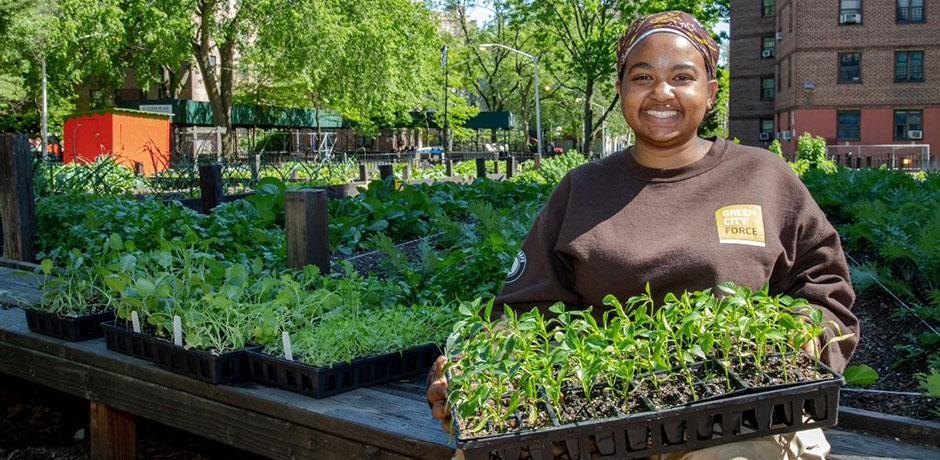The Basic Principles Of City Blooming
The Basic Principles Of City Blooming
Blog Article
The Facts About City Blooming Uncovered
Table of Contents8 Easy Facts About City Blooming ExplainedSome Known Incorrect Statements About City Blooming City Blooming Things To Know Before You Get ThisWhat Does City Blooming Do?The Best Strategy To Use For City Blooming
Intrigued in growing food to buy in the City of Chicago? Believing about beginning a community yard? Modifications to the Chicago Zoning Statute enable farming uses like area gardens and city ranches in many components of the city. Below is a list of frequently asked inquiries relating to the regulations and laws that cultivators should consider when intending a metropolitan farming project.
The zoning modification does not modify any kind of other codes managing composting, structure permits, buying or renting City possessed residential property, organization licenses or ecological contamination. There are existing codes that manage these problems and they continue to be completely effect and might apply to your project. Area yards are usually possessed or handled by public entities, public companies or community-based organizations and kept by volunteers.
Urban ranches grow food that is intended to be sold, either on a nonprofit or for-profit basis. As a result of their business objective, city ranches require a company certificate. Yes. A community garden is permitted to offer excess generate that was expanded on site if the sales are accessory or subservient to the yard's primary function defined over.
City Blooming Can Be Fun For Everyone
Composting is allowed however only for plant material that is produced and used on website. The amount of compost product can not surpass 25 cubic lawns at any type of provided time according to the standards in 7-28-715 of the City's Municipal Code. Yes. Because the soil at a lot of brand-new yard websites needs amending, garden compost, dirt, timber chips, or other products can be obtained to create or boost the growing space - fruit and vegtables.

If a building authorization is needed then the hoophouse will be thought about an accessory structure. You can learn more concerning the building authorization needs by contacting the Division of Structures. The 25,000-square-foot size limit is intended to stop a single community yard from controling a provided block or detracting from the block's existing household or commercial character.
The limitation does not use to yards located in Public Open Room (POS) areas. Can there be more than one neighborhood yard that is 25,000 square feet on a single block? Yes. The dimension restriction puts on private gardens, not to specific blocks. No. Fencing is not needed, however, yards that have big parking lot might be called for to install fence or various other landscaping functions.
The Basic Principles Of City Blooming
B1 & B2 districts need that all business use activities be performed inside. Is secure fencing required for city farms? Fences may be required, along with landscape design and screening, for specific vehicle parking areas and outside job or storage space areas depending on area and the certain activity taking area.
Urban farms call for building permits and zoning authorizations prior to building (fruit and vegtables). Other types of city evaluation might be required depending on details structures, tasks, size, landscaping, licensing, public health and stormwater management problems.
The Division of Organization Affairs and Consumer Protection can assist identify the certain type of company permit that's required. Off street vehicle parking is needed for most commercial tasks in Chicago. The called for number of parking areas is based on the number of workers functioning on website and not the square video footage of the expanding area.
A Biased View of City Blooming

An urban ranch can offer garden compost material generated on site, nonetheless, the operation needs to conform with the laws in 7-28-715 of the Chicago Municipal Code. Aquaponic systems are permitted inside on metropolitan ranches in many zoning areas.
Approximately 5 hives or colonies of honey bees might be maintained as an accessory use. Beekeepers need to register with the Illinois Department of Agriculture. To learn more regarding the recommended zoning modification you may get in touch with the Division of Housing and Economic Growth, Bureau of Preparation and Zoning at 312.744.8563.
, which takes location in rural areas at the side of residential areas.
8 Easy Facts About City Blooming Explained
It can include an activity of natural farmers, "foodies" and "locavores", who look for to develop social networks based on a shared principles of nature and area that site holism. These networks can create using official institutional assistance, coming to be integrated into neighborhood town planning as a "shift town" activity for sustainable metropolitan development.
Some of the initial evidence of city agriculture comes from Mesopotamia.
Report this page